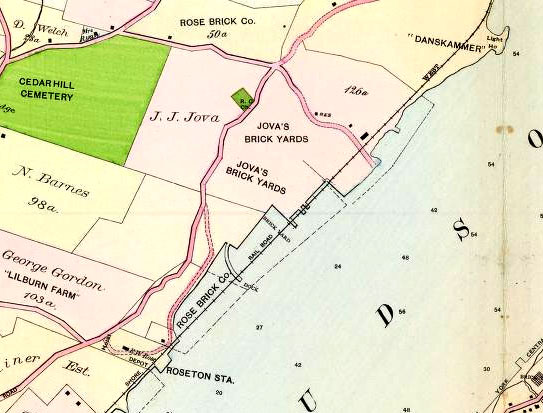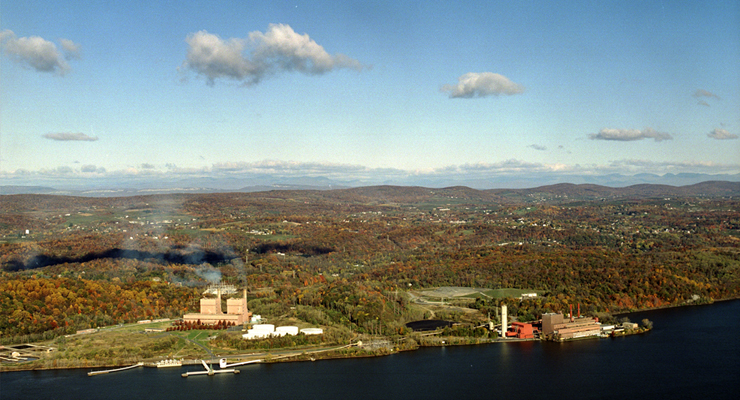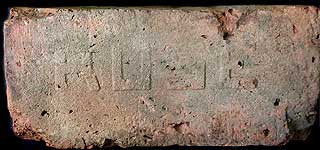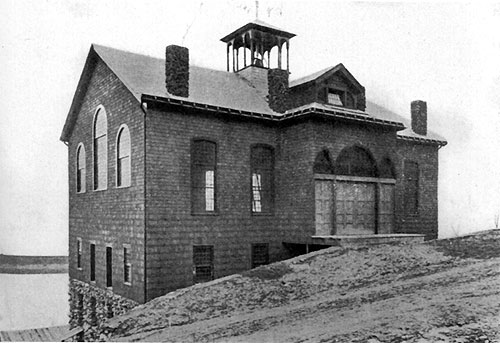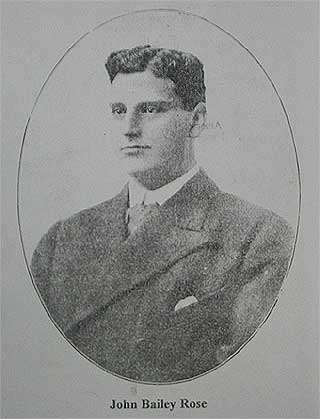|
A BRIEF HISTORY
from the perspective of |
|
"Throughout its process of brick production, the Rose Brick Company was known for the greatest care given to deliberate choices in methods of brick production. Based on thorough research and experimentation, for the most part, the Rose Company conformed to traditional methods of brickmaking with a few individual takes on this process. These included: the absence of circular pits, a drying system using only open yards to dry the bricks, excessive sweeping, lutings, and rolling of these yards, specially constructed docking facilities, and numerous culling (inspection) stations.
"The Rose Brick Company was also known for the exceptional care it provided for its workers. The surrounding community was filled with clubrooms, reading areas, stores with lower than retail prices and stocked with the best eatables, a variety of churches and Sunday schools, fairs, annual festivals, and great living accommodations. The philosophy of the Rose Brick Company was that happy, skilled workers would be the hardest workers and the best brickmakers who took pride in creating a quality product. And they were right." 4 |
In 1908, John Bailey Rose built a 3-mile long electric railway to transport the clay and sand at the upper end of the property to the brickmaking machines. He used 5 high-powered electric locomotives and 50 cars, each with a carrying capacity of 15 tons. This replaced 150 horses. Rose installed 3 electric steam shovels to load the clay into the train cars.

All waste products were re-used: broken and unsaleable/deformed bricks were ground up, pulverized and screened and then mixed with raw materials to give added strength to self-bonding gravel instead of dumping them into the Hudson River as was previously done. This gravel was used to pave the beautiful drives in Central Park and Prospect Park in Brooklyn.
The name was changed to "The Rose Brick Company" and a New York City office was opened on West 52nd Street. John Bailey Rose served on the Electoral College for President Roosevelt in 1904 and was elected to the NYS Senate in 1908.
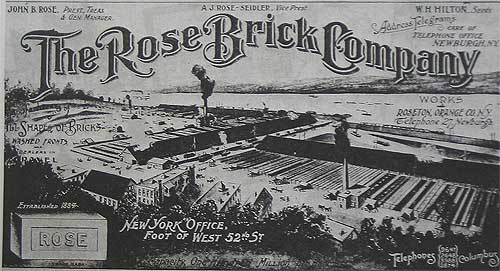
At its peak, The Rose Brick Company sold 400 million brick a year worldwide. Architects and builders recognized the superior quality of Rose-made brick. Rose Bricks were used in the Ansonia and Bell Nord Hotels, the Customs House at the Battery as well as the Empire State Building, the Linden Apartments in Riverdale, the Stock Exchange, the Singer Tower (now gone) and the Waldorf Astoria.
After the brick yards shut down, the Central Hudson Gas & Electric Company purchased them and most of the private property for expansion of its power plants, and demolished all of the homes east of River Road -- almost the entire community.

Our Lady of Mercy Chapel
The only major building surviving from the original Roseton is Our Lady of Mercy Chapel, a mission church of St. Mary's Parish in Marlboro, NY. The wife of brickmaker Juan Jova (scroll down for the Jova story) sponsored the 1887 construction of this notable brick church. It long served the Roman Catholic community in Roseton and is still in service. While it has offered only one Mass per week since the expansion of the power plants, most times the Mass is standing room only.1
"In 1949, Angelo Sasso bought the home of the former Senator Joseph (sic) B. Rose. The Rose's had started one of the first brickyards in the area and the community of Roseton took its name from the Rose family. Angelo and his wife Carole named the new restaurant the Beau Rivage and it became famous for dining in beautiful aesthetic surroundings...Angelo entered into rest on Jan. 16, 2006."3
The Roseton post office, with its own zip code (12576), was closed down the mid 1970s.
The Rose brickyard is now the site of the present Hess Oil terminal.
DANSKAMMER, Phase 1
The ARMSTRONGS and ARROW BRICK:
"At that time, before the brick-yards came, scarring the landscape and even gnawing away our lawns and gardens, the situation was beautiful, crowning a wooded plateau, with a sweeping view across Newburgh bay to the Highlands. We had a delightful bathing-beach of firm white sand, now of course swallowed up by the West Shore Railroad, and a dock where large vessels could land. The river was very gay in those pre-railway days, dotted with hundreds of sails, sloops, and schooners plying between New York and Albany.
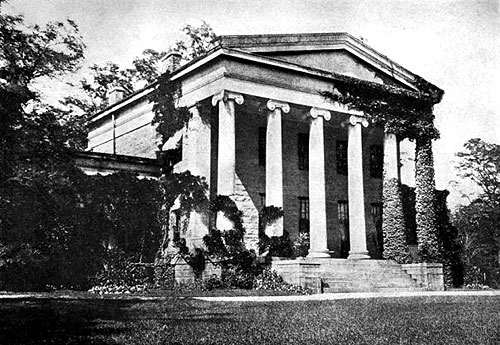
The Armstrong Mansion at Danskammer Point
In Day Before Yesterday: Reminiscences of a Varied Life, David Maitland Armstrong (1836-1918) continues: "After my father bought Danskammer he added to it various farms until he had a river-front of about two miles, from Mudhole nearly to Hampton both these little places have changed their names and are now known as Roseton and Cedar Cliff.
"My father had a substantial taste in houses; he built his new house of granite, in the classic style which was the fashion of the day, and finished it throughout in black walnut. The dark-colored granite came from Breakneck, near Cornwall, and the light granite of which the columns and trimmings are made was from Quincy, Massachusetts. I have heard that when the columns were landed at our dock there was a great question as to how to get them up the hill, as they were enormous. They finally drilled holes in the ends and made rollers of the columns themselves, and by attaching a tongue were able to roll them up to the house."2 (Read More)
The granite stones and Ionic Columns survive to this day:

Ionic Columns from the Armstrong Mansion at Danskammer Point
Now on Display at the
Storm King Art Center
A description of the Museum Building at the Storm King Art Center states: "Completed as a residence in 1935 for the late Vermont Hatch, the French Normandy-style building was designed by architect Maxwell Kimball. The building's granite stones were salvaged from Danskammer, the 1834 Edward Armstrong mansion located north of Newburgh that stood overlooking the Hudson River for almost 100 years. The five Ionic columns now situated on the Art Center's property formed the front of Danskammer."
A bit of Armstrong family history: During the American Revolution, Colonel William Armstrong, a native of Scotland, came to America with the British Army, attached to Headquarters in New York. After the war, he stayed on and bought land in the Orange County area. His son, Edward became a farmer and vestry man at the Episcopal Church in Marlboro, NY. Many of the family are buried in the church cemetery. In the 1820s Edward Armstrong purchased land about 60 miles north of New York city on a point jutting into the Hudson on the west shore. Edward had four sons: William Henry, Gouverneur, John and David Maitland.
David Maitland Armstrong, the youngest of the four boys, married Helen Nelson, a descendant of Peter Stuyvesant and niece of Governor Hamilton Fish. David was admitted to the bar, but gave up law to study art in Paris and Rome, becoming a specialist in stained glass windows (as did his daughter) and examples of their work can be seen in many of New Yorkís churches as well as the Episcopal church in Marlboro, NY. 8
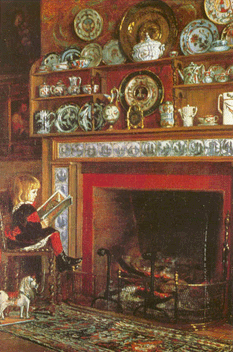
"The Chimney Corner" by David Maitland Armstrong,
painted at Danskammer
(It is believed this is a portrait of his son, Edward. See
Gomez Mill House).
Again quoting David Armstrong: "My father settled in this part of the country because my grandfather, Colonel William Armstrong, of the British army, had been greatly struck by the beauty of the neighborhood when he visited Newburgh during the Revolution. Colonel Armstrong was a Scotchman; he got his commission as lieutenant when he was nineteen, and soon after came to this country with Sir Henry Clinton, and served all through the Revolution, being wounded in the battle of Princeton, and losing an eye in the battle of Stony Point. He surrendered with Cornwallis at Yorktown. It is amusing to remember that my wife's grandfather, Colonel Nicholas Fish, was also present at Yorktown, on the winning side; I wonder if the two grandfathers ever met."
From time to time, the Armstrongs rented Danskammer to John Chandler Bancroft Davis (1822-1907) (better known as Bancroft Davis) of Orange County, NY. Born in Worcester, MA on December 29, 1822, he was a lawyer; member of New York state assembly from Orange County 1st District in 1869; U.S. Minister to Germany from 1874 to 1877; Judge of U.S. Court of Claims from 1878 to 1882; official reporter, U.S. Supreme Court in 1883 and president of the Newburgh and New York Railway Company.7

Bancroft Davis
David Armstrong wrote: "Bancroft Davis went to Danskammer for his health, he had broken down from overwork and was supposed to have only one lung, but country life completely restored him. The Davises were much given to hospitality and kept open house at Danskammer, liking it there so much that later they bought land from us, and Richard Hunt built them a beautiful house in the style of Fontainebleau, costing about a hundred thousand dollars. This lovely place, "o'erlooking the tranquil bay," was afterward sold to the Rose Brick Company (scroll up on this page for Rose information), and has now entirely disappeared all made into bricks!" 2
Even though Maitland Armstrong scoffed at "the brick-yards, scarring the landscape and even gnawing away our lawns and gardens," ironically, our research finds that in 1905 Maitland Armstrong ran the Arrow Brick Co., located on Danskammer Point and produced 5 million brick.
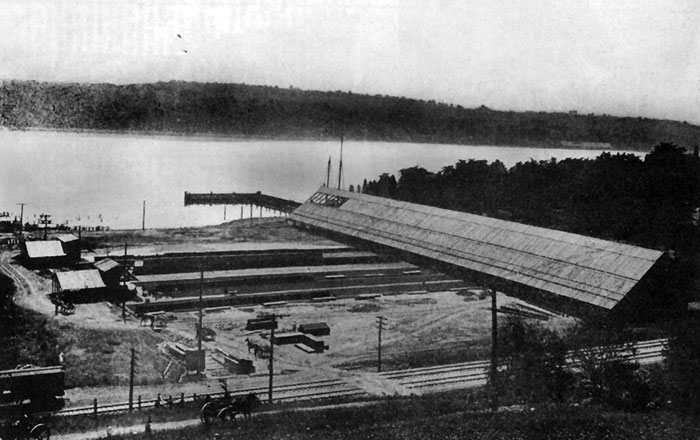
Arrow Brickyard, 1905
We've also found information that his son, Edward (the little boy in front of the Danskammer fireplace), may have operated the yard with his dad. The discovery of Native American artifacts at the excavation site led to the company's name.
"The Arrow brick Works provide a good example of young enterprise achieving the American dream. While the neighboring brickyards were turning out dozens of millions of bricks a season, the new company was able to produce over 5,000,000 in its first season, more than doubled its production by the next year, and by its third season was producing over 20,000,000 bricks annually. The owner, Mr. E.M. Armstrong, believed that, 'thoroughly modern equipment, with the best quality of clay and sand in the Hudson Valley, and an invincible determination to succeed, would surely carry the Arrow brand to its mark.'" 4
Recent Satellite View of Roseton and Danskammer Point
"A" marker shows power plant at Danskammer Point today.
(Drag map with mouse, zoom in with +, zoom out with -)
1891 Map (by Beers) showing Roseton Station, Rose Brick Company,
neighboring Jova Brick Yards and Danskammer (with Light House)
The small green area at the upper center is Our Lady of Mercy "R. C. Ch"apel.
Click for Larger View.
DANSKAMMER, Phase 2
The JOVAS:
In the late 1800s, Juan Jacinto Jova (J J J) came from Cuba to New York City as a sugar broker, then moved up the Hudson River to Roseton, NY, where he had hoped to raise sugar cane. When that venture failed, he built a brick plant. In 1874 Jova bought a large Greek revival granite mansion (Danskammer) from David Maitland Armstrong (who ran the ARROW Brick Co., described above). Eventually he tore it down to get the clay on which it stood. 13
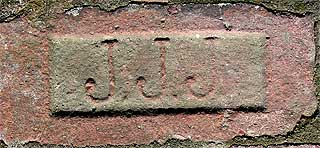
Juan Jacinto Jova
(Photo taken in 2007 of a brick in a sidewalk at Provincetown, Cape Cod, MA)
"Juan Jacinto Jova...began brickmaking in 1884, at what was to become known as Roseton...The Jovas had their origins in Catalonis, the northeastern province of Spain, which was known for its industrious and resourceful people, as well as being a principal source of entrepreneurs for the Spanish colonies."6
After his untimely death in 1894, Jova's four sons (Henri, Edward, Joseph and John), known locally as "The Jova Boys," continued the business.

(brick found by Bill of St. James, NY)
"Bricks produced here sold at among the highest prices - second only to those of the Rose Company. The character of the clay deposits of these two companies was basically identical. The Jova banks were set along the highest banks on the Hudson River, at 140 feet above the level of the water.

(from the webmaster's collection and found in Chester, NY)
"Everything in the Jova plant was on a large scale, comprising eleven sod pit machines, and producing 33,000,000 bricks per season. In 1904, they had calculated that they could continue to produce bricks at that capacity, on site, for another 200 years. Coal was used exclusively in the kilns and blue clay was used almost exclusively in the pits. Their preference for natural color led to this rigid exclusion of pigments in the pits.
"The Jova plant had a policy of employing only first-rate experts as foremen and superintendents for Mr. Jova was proud of the product his company manufactured. He believed that while the reputation of the company would suffice, perhaps, to sell the brick on the merits of the brand, the elaborate care expended from every detail of the making and the excellence of the material at their command would create a market for the brick, even if the past record of the brand were entirely forgotten.
"Jova bricks were used in the construction of the Custom House at Bowling Greene, of the Brooklyn Navy Yard buildings, and of the Public Library building of the City of New York completed in 1903."4
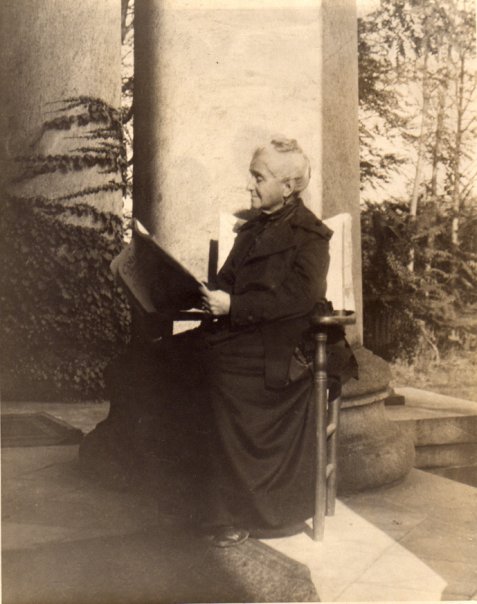
Marie Jova at Danskammer
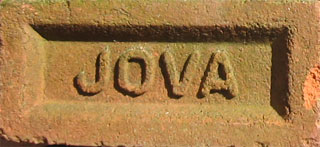
Henry J. & Edward A. Jova
Roseton, NY (1900) 14 machines
(found in Pelham Manor, NY)
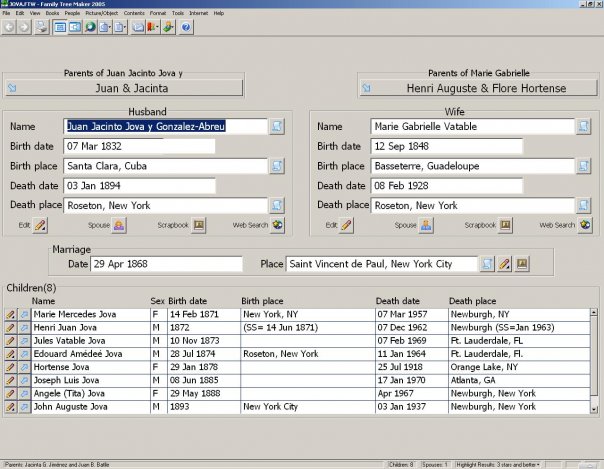
Jova Family Lineage
The Jova Company September, 1939
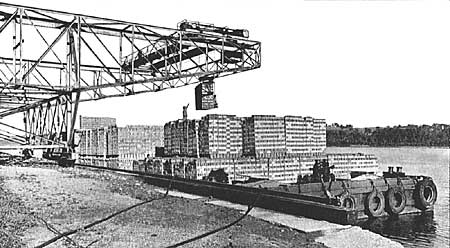
Overhead Crane on Gantry Loading Barge
(Courtesy of Hudson River Brick by Brick Manufacturers Association of New York)
Brick Cars
(Gottscho-Schleisner Collection - Library of Congress)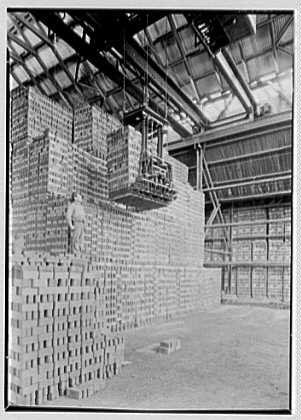
Loading from Brick Pile
(Gottscho-Schleisner Collection - Library of Congress)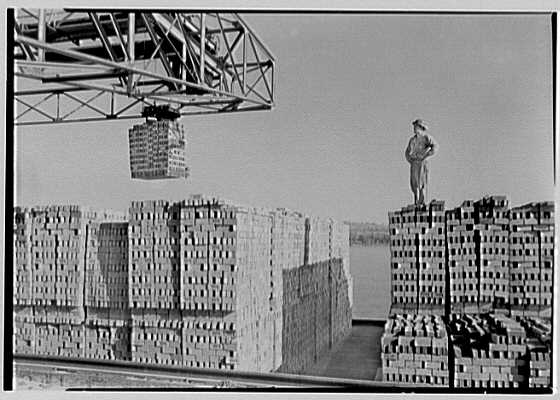
Barge Loading
(Gottscho-Schleisner Collection - Library of Congress)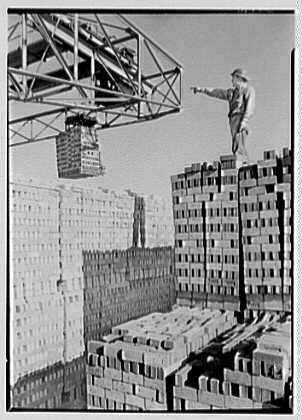
Barge Loading Closeup
(Gottscho-Schleisner Collection - Library of Congress)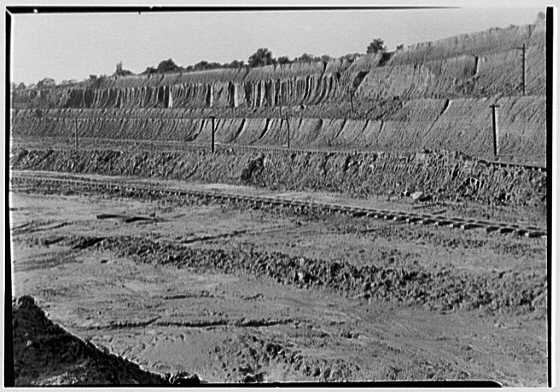
Clay Bank
(Gottscho-Schleisner Collection - Library of Congress)
Jova Manufacturing Company
East Kingston, NY (1965)
According to George Hutton in The Great Hudson River Brick Industry, JMC was the brand used for Jova brick made after the Jova Company bought out the Hutton plant in East Kingston in 1965. (The HUTTON brand was retained for a premium line of brick.)
ADDITIONAL LINKS and INFORMATION:
"Opposite Carthage is Roseton, once known as Middlehope, and above this we see the residence of Bancroft Davis and the Armstrong Mansion. We now behold on the west bank a large flat rock, covered with cedars, recently marked by a lighthouse, the Duyvel's Dans Kammer.
Here Hendrick Hudson, in his voyage up the river, witnessed an Indian pow-wow: the first recorded fireworks in a country which has since delighted in rockets and pyrotechnic displays. Here, too, in later years, tradition relates the sad fate of a wedding party. It seems that a Mr. Hans Hansen and a Miss Kathrina Van Voorman, with a few friends, were returning from Albany, and disregarding the old Indian prophecy, were all slain:
"For none that visit the Indian's den Return again to the haunts of men. The knife is their doom! O sad is their lot! Beware, beware of the blood-stained spot!"
Some years ago this spot was also searched for the buried treasures of Captain Kidd, and we know of one river pilot who still dreams semi-yearly of there finding countless chests of gold." 10
In The Hudson River Guidebook, Arthur Adams describes the Danskammer:
"A low flat, rocky point jutting out into water 36 feet deep, it was long a menace to navigation. Formerly there was a projecting point. This was broken off when it was run into by the large steamer Cornell one misty morning in 1890. The present lighthouse was built on the fragments which fell into the water. It takes its name from the Dutch "teufelís danskammer" or devilís dancehall". This name was given it by Lt. Cowenhoven in 1663, who saw Indians doing ceremonial dances there by firelight."
The Danskammer Point Lighthouse
By Warren Mumford:
"Many have probably heard of the 'Devilís Dance Chamber' or 'Danskammer,' the name coined by the early Dutch for the point two miles north of Newburgh on the west side of the Hudson. The Dutch legend is that Indians used the point for devilish ceremonies. Now the point is lighted by the fires of the Dynergy (originally Central Hudson) power plant.
"Largely forgotten, however, is that for a period following the campfires of the Indians and prior to the engines of industry, the point was lighted to keep mariners on course as they steamed up and down the river.
Several years ago, I had a conversation with a 90-year-old gentleman, by the name of Maitland Wiest (now deceased), who told me that his grandfather was keeper of the light at Danskammer during WWI." Read about the Danskammer Point Lighthouse
Additional Armstrong Family History:
This family estate originated with the purchase of land by Edward Armstrong (1800-1840) the son of William Armstrong (1750?-1830?), a former British naval officer and Margaret Marshall Armstrong in the 19th century. He built a house called "Danskammer" that remained in family hands until a descendant sold it off in the 1970ís or 80ís.
David Maitland Armstrong (1836-1918) is noted for his prominent careers first as a diplomat and also as a graphic artist. Armstrong was born in Danskammer, near Newburgh, N.Y. He attended Trinity College in Connecticut from which he received a Bachelorís degree in 1858. In 1862, Armstrong received a Master of Arts diploma and admitted to the bar the same year. Armstrongís demonstrated knowledge of law and his familiarity with Latin countries resulted in his appointment as American Consul to the Papal States. During his tenure in this position, Victor Emmanuel took Rome (1870) and subsequently, Armstrong received the appointment as Consul General to Rome.
In 1872, Armstrong returned to United States and devoted himself to the art of design possibly being the inventor of the American opalescent stain glass. Returning to Europe several years later, Armstrong went to Paris as head of the American Art Department of the Paris Exposition (1878). At the time of Armstrongís death in New York City at the age of 83, he headed the firm "Maitland, Armstrong & Co.," and with his daughter Miss Helen Maitland Armstrong, Armstrong designed memorials and church windows throughout the country. His survivors were his wife Helen Neilson Armstrong and his children.12
Environmental Developments:
In the 1930s, power generating stations were built on the brickyard sites by Central Hudson Gas & Electric.
In 2001 Central Hudson sold both Roseton and Danskammer to Dynegy, under new rules deregulating electricity, in order to become just a distributor of power. Dynegy later added a facility that allowed the plant, which had previously received coal only by rail, to receive coal from self-unloading ships.
Shortly afterwards, environmental activists began to raise concerns about the plant's emissions. According to Environmental Protection Agency figures, it was among the top ten releasers of pollutants by weight in New York, releasing 1.4 million pounds (560,000 kg) of hazardous emissions in 2000. Dynegy defended its operation of the plant as entirely within its permits.
The environmental group Riverkeeper took note of the long-overdue renewal of the plant's discharge permit from the state Department of Environmental Conservation (DEC). In common with Roseton and Indian Point Energy Center, its use of once-through cooling, in which river water was pumped in, used to cool the plant, then pumped out warm, dated to the 1950s and was responsible for large fish kills in the river. A state judge had voided the permit, but it was reversed on appeal. After DEC rebuffed Riverkeeper's effort to force it to accelerate the process, and ruled that closed-cycle cooling, the environmental group's preferred alternative, was not feasible at Danskammer, Riverkeeper filed suit against DEC and Dynegy alleging violations of state administrative-procedure law in issuing the new permit. They alleged that DEC had accepted Dynegy's argument that it didn't have space to install closed-cycle cooling despite the company owning large tracts of adjacent vacant land, and that it had allowed Dynegy to account for its water withdrawals in an unrealistic fashion. Dynegy says there are cheaper alternatives to the cooling towers a closed-cycle system would require.
Shortly afterwards, environmental activists began to raise concerns about the plant's emissions.11
Sources Consulted:
2Armstrong, Maitland, "DAY BEFORE YESTERDAY: REMINISCENCES OF A VARIED LIFE"
3"Times Herald-Record," https://archive.recordonline.com/archive/2006/01/19/obituaries.html
4Durbak, Katrina, "Making Bricks in the Hudson River Valley at the Dawn of the 20th Century"
(https://www.columbia.edu/itc/barnard/envsci/bc3023/edit/brickworks/index.html)
5Gottlock, Wesley and Barbara H., Lost Towns of the Hudson Valley
6Hutton, George, The Great Hudson River Brick Industry
7https://en.wikipedia.org/wiki/Bancroft_Davis
8https://www.gomez.org/Armstrong.html
9GENEALOGICAL AND FAMILY HISTORY OF SOUTHERN NEW YORK AND THE HUDSON RIVER VALLEY, 1913 A RECORD of the ACHIEVEMENTS of HER PEOPLE in the MAKING of a COMMONWEALTH and the BUILDING OF A NATION; NEW YORK, LEWIS HISTORICAL PUBLISHING CO. 1913
10https://www.accessgenealogy.com/newyork/hudson/newburgh_poughkeepsie.htm#Kammer
11https://en.wikipedia.org/wiki/Danskammer_Generating_Station
12https://legacy.www.nypl.org/research/chss/spe/rbk/faids/armstrongneilson.pdf
13Pixley, Francis V., Remembering Pix (Pixley was a ceramic engineer and co-founder of Kil-Tel Systems Inc. He worked summers at the Jova Brick Company founded by his grandfather, Juan Jacinto Jova.)
 Hudson River Brickmaking | Brick History/How Bricks Were Made Links | Contact Form | IBCA | BOOK SHOP Visitors' Comments/Collections/Brix Pix | Our Collection and Brick Identifier HOME
|
